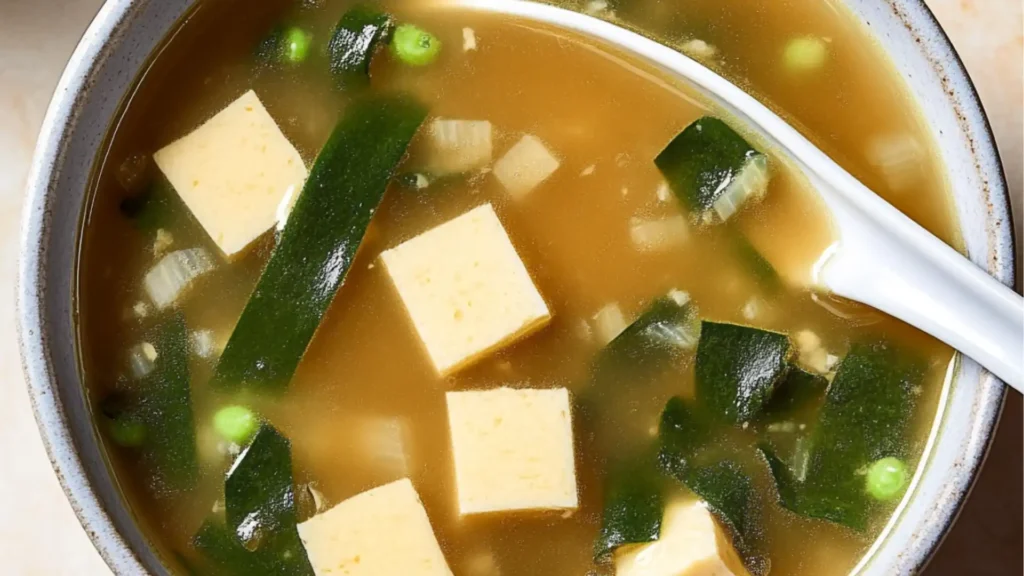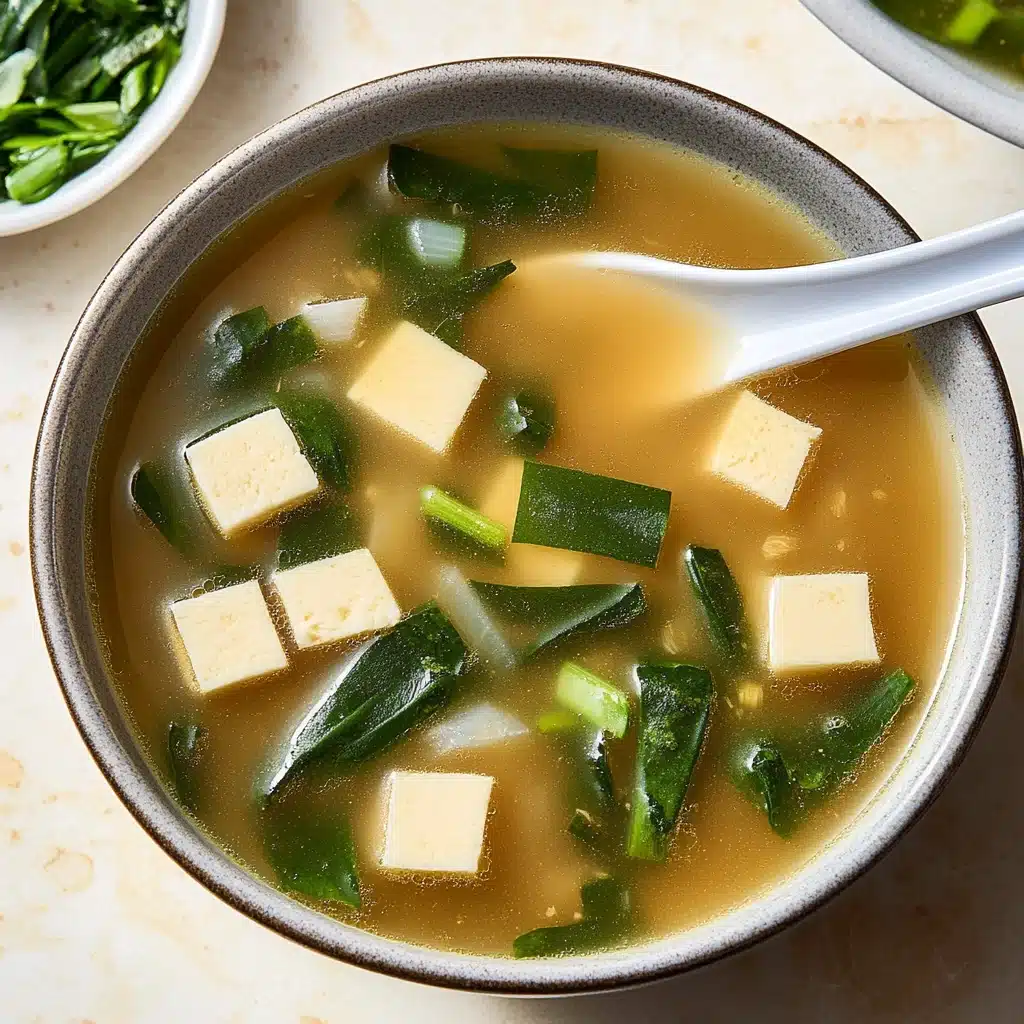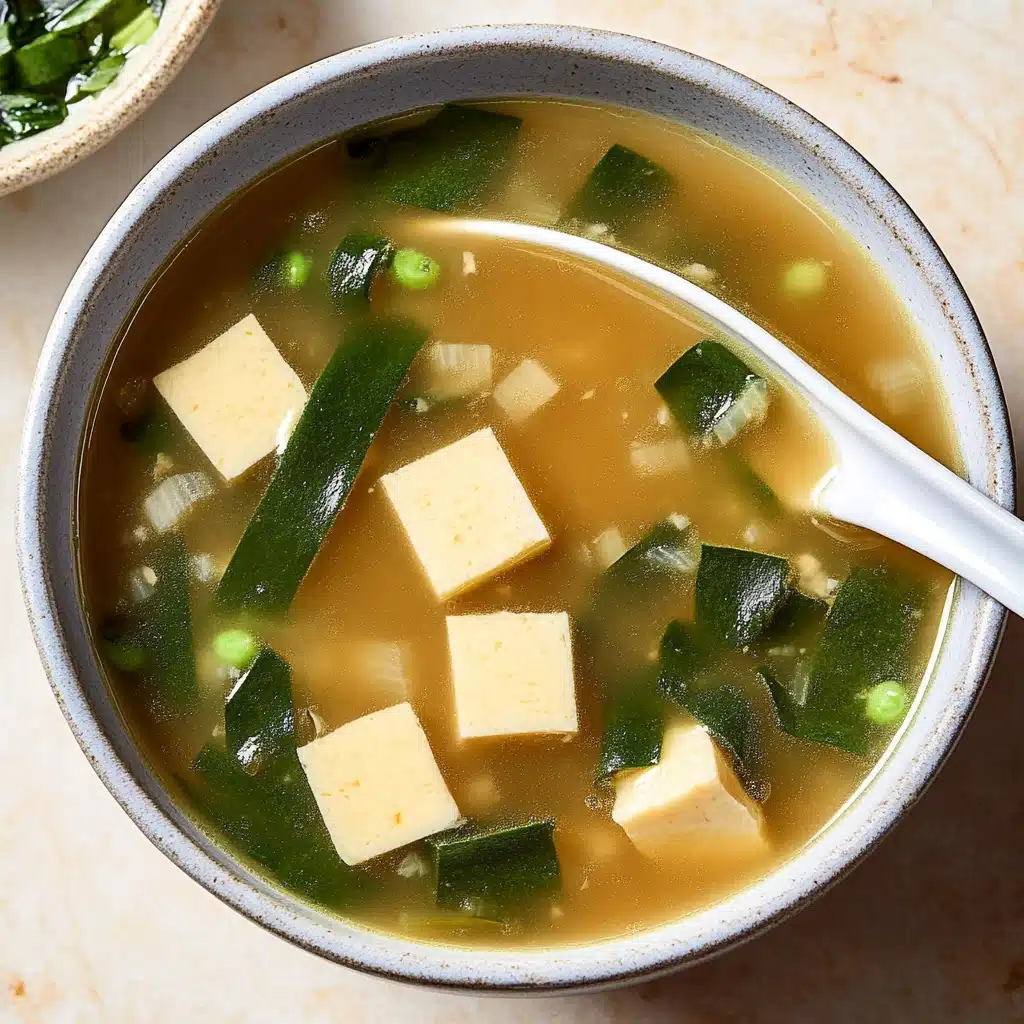Warm, light, and packed with umami, miso soup is one of the most iconic and nourishing staples in Japanese cuisine. Whether enjoyed as a cozy side dish or a quick meal on its own, it offers comfort and flavor in the simplest form. This miso soup healthy dinner Asian recipe is not only easy to prepare, but it’s also a go-to option for anyone seeking a clean, non-oily, and probiotic-rich dish that’s ready in minutes.
Perfect for a healthy Japanese lunch, post-work dinner, or even a light start to a multi-course meal, this authentic miso soup recipe gives you all the flavors of a traditional Japanese kitchen right from home.
Table of Contents
Why This Japanese Miso Soup Recipe Stands Out
While many versions of miso soup exist, this one strikes the ideal balance between flavor, ease, and tradition. Here’s what makes it special:
- Uses authentic Japanese ingredients like dashi and wakame
- Ready in under 15 minutes
- Naturally gluten-free and vegetarian (or easily adaptable)
- Filled with nutrients and probiotics
- Perfectly portioned for one or easily scaled for more
Unlike store-bought or overly complex variations, this version of miso soup healthy dinner Asian keeps it simple and traditional.
Ingredients for Authentic Miso Soup Recipe
To make this warming bowl of miso soup, you’ll need the following:
- 2 cups water
- 1 teaspoon dashi granules (or homemade dashi)
- 1½ tablespoons white or yellow miso paste
- ⅓ cup soft tofu, cut into small cubes
- 1 tablespoon dried wakame seaweed
- 1 tablespoon chopped scallions (optional)
These ingredients come together to create a savory, balanced soup with minimal effort.
Kitchen Tools You’ll Need
Miso soup is low-maintenance and only requires a few basics:
- Small saucepan
- Measuring spoons
- Fine mesh strainer (optional, for miso paste)
- Ladle
- Small soup bowls for serving
For a more refined texture, you can strain the miso paste to remove clumps—but this is optional.
How to Make Miso Soup (Step-by-Step Guide)
Making authentic miso soup at home is surprisingly easy. Here’s how to do it:
1. Heat the base:
In a small saucepan, bring the water to a gentle simmer. Add the dashi granules and stir to dissolve. This creates the umami-rich base of your soup.
2. Soak the wakame:
While the water heats, soak the dried wakame in a small bowl of warm water for about 5 minutes, or until it rehydrates. Drain and set aside.
3. Add the tofu:
Gently add the cubed tofu into the pot. Simmer on low for 2–3 minutes to warm it through.
4. Add miso paste:
Turn off the heat. Place the miso paste in a ladle or small bowl, add a bit of the hot broth, and stir until smooth. Then return this mixture to the pot, stirring gently to combine. Do not boil miso—this destroys its nutrients and flavor.
5. Add wakame and scallions:
Stir in the soaked seaweed and scallions (if using). Taste and adjust miso if needed.
Serve hot, and enjoy immediately.
What Makes Miso Soup a Healthy Japanese Lunch or Dinner?
Miso soup isn’t just delicious—it’s incredibly good for you. Here’s why this healthy Japanese lunch or dinner is such a great choice:
- Low in calories but rich in nutrients
- Fermented miso is a probiotic powerhouse
- Seaweed (wakame) is high in iodine, calcium, and magnesium
- Tofu adds plant-based protein
- Dashi provides essential umami without excess fat
It’s also a great choice for those seeking non oily food recipes that satisfy without feeling heavy.
Common Mistakes to Avoid in Miso Soup Recipes
Even a simple soup can go wrong without a few key tips. Here are some pitfalls to avoid:
- Boiling the miso: Always add miso after removing the soup from heat to preserve its flavor and probiotics.
- Using too much miso: Start small—it’s salty and strong. You can always add more.
- Skipping dashi: Water alone won’t give the same umami base. Dashi is essential.
- Overcooking tofu: It can fall apart if simmered too long.
Follow these tips and your miso soup recipe authentic taste is guaranteed.
Variations: Pork Miso Soup, Veggie Miso, and More
Looking to make your miso soup more substantial or suited to different diets? Here are a few variations:
- Pork Miso Soup: Add cooked, sliced lean pork or ground turkey for a heartier version. Sauté separately, then add with tofu.
- Vegetable Miso Soup: Add spinach, napa cabbage, shiitake mushrooms, or thinly sliced carrots.
- Spicy Miso Soup: Add a pinch of chili flakes or a dab of chili paste.
- Miso Udon Soup: Add cooked udon noodles and turn it into a filling meal.
Keep in mind to never overpower the subtle miso flavor with too many ingredients.
Serving Suggestions for Miso Soup Healthy Dinner Asian Style
Miso soup is incredibly versatile and can be served in many ways:
- With a side of steamed rice
- As a starter to a bento box-style meal
- Alongside a cucumber salad or blanched green beans
- With a main like Slow Cooker Honey Garlic Chicken
- As part of a vegetarian sushi night
It’s also ideal for small servings, making it the perfect healthy lunch for one or a light appetizer for a larger group.
How to Store and Reheat Leftover Miso Soup
To store:
Refrigerate leftovers in a sealed container for up to 3 days.
To reheat:
Warm gently on the stove over low heat—do not boil—especially once miso has been added. You can also reheat tofu and wakame separately and stir in freshly dissolved miso for best results.
To freeze:
It’s best to freeze the dashi, tofu, and vegetables without the miso. Add fresh miso when reheating for optimal taste and nutrition.
Non Oily Food Recipes: Why Miso Soup Fits the Bill
Many people seek out non oily food recipes for health, digestion, or dietary preferences. Miso soup fits that perfectly:
- No added oils or butter
- Naturally light but flavorful
- Rich in umami without heaviness
- Free from processed ingredients
It’s a feel-good meal that tastes indulgent but supports your health goals.
Miso Soup FAQ
What kind of miso should I use?
White miso is the mildest and most versatile. Red miso is stronger and saltier. Use according to your taste.
Is miso soup gluten-free?
Yes—if you use gluten-free tamari instead of soy sauce and check your miso paste label.
Can I make miso soup ahead of time?
Yes, but store the broth and miso separately if possible. Reheat gently and add miso just before serving.
Can I add noodles?
Absolutely! Udon or soba noodles make it a heartier meal.
Final Thoughts: A Nourishing Bowl for Any Day
This miso soup is the perfect example of how simple ingredients can create something deeply nourishing and flavorful. Whether you’re preparing a healthy Japanese lunch or a clean Asian dinner, this dish offers flexibility, nutrition, and a satisfying umami taste that never goes out of style.
Make it once, and it’ll become a regular part of your weekly routine.
PrintMiso Soup – A Nourishing and Authentic Japanese Classic
- Total Time: 15 minutes
- Yield: 2 servings 1x
Description
This authentic Japanese miso soup is light, savory, and deeply comforting. Made with dashi broth, miso paste, tofu, wakame seaweed, and scallions, it’s a probiotic-rich, plant-based dish perfect as a starter, side, or light meal. A simple, clean, and nourishing soup ready in under 20 minutes!
Ingredients
- 2 cups water
- 1 piece dried kombu (about 4 inches long)
- 1 tsp bonito flakes (optional, skip for vegetarian/vegan)
- 2 tbsp white or yellow miso paste
- ¼ cup silken tofu, cubed
- 1 tbsp dried wakame seaweed
- 2 tbsp chopped scallions
Instructions
- Prepare dashi: Soak kombu in water for 5 minutes, then bring to a gentle simmer. Remove kombu before boiling. If using bonito flakes, add them, steep 2 minutes, then strain.
- Hydrate wakame: Soak dried wakame in water 5–10 minutes, then drain.
- Dissolve miso: Mix miso with a little hot dashi in a small bowl until smooth. Stir back into pot (do not boil after this step).
- Add tofu & wakame: Stir gently into the soup. Heat through 2–3 minutes.
- Garnish & serve: Top with scallions and enjoy warm.
Notes
- Do not boil miso after adding—it kills probiotics and alters flavor.
- Use silken or soft tofu for best texture.
- For vegetarian/vegan: make kombu-only dashi and skip bonito flakes.
- Experiment with add-ins like mushrooms, spinach, or noodles.
- Store broth separately and add miso/tofu fresh for best leftovers.
- Prep Time: 5 minutes
- Cook Time: 10 minutes
- Category: Soup, Side Dish, Japanese Recipes
- Method: Stovetop
- Cuisine: Japanese
Nutrition
- Serving Size: 1 bowl
- Calories: 70
- Sugar: 2g
- Sodium: 700mg
- Fat: 3g
- Saturated Fat: 0.5g
- Unsaturated Fat: 2.5g
- Trans Fat: 0g
- Carbohydrates: 6g
- Fiber: 1g
- Protein: 5g
- Cholesterol: 0mg
Keywords: Miso Soup, Authentic Japanese Miso Soup, Vegan Japanese Soup, Easy Miso Recipe, Healthy Soup







